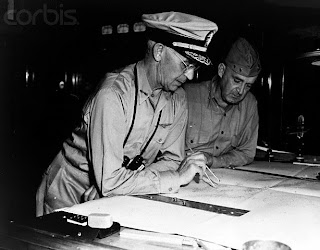 This week I spent a few days with my key leaders thinking through our strategic plan for this next fiscal year. This is a critical planning event that serves to ensure that our resources are aligned against our priorities, that we understand our mission, and that we affect the sorts of changes that are necessary to avoid complacency and irrelevance.
This week I spent a few days with my key leaders thinking through our strategic plan for this next fiscal year. This is a critical planning event that serves to ensure that our resources are aligned against our priorities, that we understand our mission, and that we affect the sorts of changes that are necessary to avoid complacency and irrelevance.While I won't drag you through the details of the planning process (you can remind yourself of the key elements in the 5-part Mission Planning series, see Part I here), I do want to share with you how we set the conditions for our discussions. In the decision-making process it is the key first step in which we define the problem. This is the baseline against which strategic plans can be developed. If you haven't defined the problem, you are likely to come up with a pretty plan that won't see the light of day (and how many of us have been a part of those efforts?).
In the military planning process, Step 1 is to conduct Mission Analysis. This is the sort of detailed review that allows leaders to: See yourself; See the Enemy; See the Terrain. Now, before you think this is reserved for the military, think of it as a SWOT Analysis, with which most non-military leaders are comfortable: Analyze Strengths and Weaknesses (See Yourself), Understand your Opportunities (See the Terrain), and Know your Threats (See the Enemy) -- SWOT. This SWOT analysis is the type of review that must be completed before entering into detailed planning steps.
What I thought was worth sharing with you was the information we gathered as part of our SWOT or Mission Analysis. These are the elements that I felt contributed to the development of a plan that addressed our critical needs:
-- Internal workforce survey. What was working and where did we need improvement in issues like culture, values, counseling, and resource alignment? There is nothing like hearing these issues straight from your teammates.
-- Customer surveys. What do our customers think about our services and how we measure against critical issues like cost, schedule, and communication? Continued relevance demands that we have a finger on the pulse of our customers and their needs.
-- Recent After Action Reviews (AARs). We did not put our recently completed fiscal year "to bed" until we had completed a detailed examination of our successes and challenges. The former need sustainment while the latter demands our attention for key improvements that we know we must make.
-- We conducted a detailed analysis of the mission from our higher headquarters. Any plan we put together MUST address the specified and implied requirements from my boss. We reviewed their strategic plan to ensure that anything we might do is aligned with the vertical team.
-- We looked at our current plan. What actions were completed and where were we making progress...or not? Our strategic plan this year is likely to be continued progress toward our shared vision rather than a complete re-write so best to begin with an examination of how we are doing toward those goals.
-- We looked at data. What are revenue projections for the next few years? What are the implications for our workforce? Does any of it suggest a requirement for a different size or shape of the organization or different skills among our team? What are our demographics and does it suggest anything for the future composition of our team (retirement eligibility, grade and skill distribution, diversity, retention, etc.)?
-- We examined any future opportunities that we needed to consider or any threats that might cause problems for our team and its mission.
-- Finally, I gave my read of the terrain as the organizational leader. It was my assessment of those priority actions that needed to be included in our plan. It was my VOTE before break-out sessions that would build a detailed plan. I wanted to shape the future with some key points and emphasize their importance to my leaders.
None of this is transformational. But it certainly helped us put all of our cards on the table before we started shuffling them. Too often, plans are developed without a thorough understanding of the problem. Sure, we can come up with a plan but if it does not address customer needs, if it does not account for challenges within the workforce, and if it does not take advantage of future opportunities, it is likely to be a strategic plan that does like so many -- gathers dust on the shelf. No progress, no alignment, and no likelihood for the sort of impact that we expect from these efforts.
Have you held this sort of detailed, disciplined review session with your leaders lately? If you have, did you gather the necessary planning tools that would lead to realistic and relevant goals and objectives? If you have not, can I help you get started? Drop me a note and let's talk about your strategic planning process.
Our SWOT definitely set the conditions for a great planning session. This may not be a comprehensive list but it gives you an idea of the sorts of things that we needed to consider as part of our mission analysis. I think our leadership team believes that it helped produce a refreshed strategy that is what we need to improve our performance, align our resources, increase market share, and have a successful, relevant future. And that makes this critical first step of the planning process...Leader Business.
Image from www.corbisimages.com
No comments:
Post a Comment